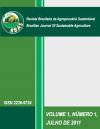RECOMMENDATION OF FERTILIZERS BASED ON THE LAW OF DIMINISHING RETURN
DOI:
https://doi.org/10.21206/rbas.v1i1.12Abstract
The objective of this work was to demonstrate the viability of making recommendation of fertilizers for corn and bean cultures based on models of saturation kinetics, following the Law of diminishing return, aiming to improve the efficiency of nutrient use, reducing the costs of production and avoiding the excessive use of non renewable natural resources. In the corn culture (grain hybrid) they were utilized levels of 0.0, 0.25, 0.5, 1, 2, 4, 8, 16 and 32 g/hole of fertilizer NPK 4-14-8 in seeding and same amounts of ammonium sulfate 34 days later. The space between plants was of 20 x 70 cm (71.429 plants/hectare), with eight replicates per each level, totalizing 72 plants in the experimental area. In bean culture (red variety) they were utilized levels of 0.0, 0.25, 0.50, 1, 2, 4, 8, 16 and 32 g/hole of NPK 4-14-8 in planting. The space between plants was of 20 x 50 cm, with two grains per hole (71.429 plants/hectare), with eight holes per each level, totalizing 144 plants in the experimental area. The models of saturation kinetics of Lineweaver-Burk presented good adjustments for responses of corn and beans to fertilization, following the Law of diminishing return, in which 4 to 8 g of fertilizer per hole caused good part of the productive response for corn and 2 grams for bean. The employee of moderate level of fertilization leads to a more sustainable and economically viable agriculture to the household producer.Downloads
Download data is not yet available.
Downloads
Published
2011-07-01
How to Cite
Geicimara Guimarães, Rogério de Paula Lana, Maria Regina de Miranda Souza, Bruno Pietsch Cunha Mendonça, & Elton Eduardo Novais Alves. (2011). RECOMMENDATION OF FERTILIZERS BASED ON THE LAW OF DIMINISHING RETURN. Brazilian Journal of Sustainable Agriculture, 1(1). https://doi.org/10.21206/rbas.v1i1.12
Issue
Section
Artigos
License
1. Proposta de Política para Periódicos de Acesso Livre
Autores que publicam nesta revista concordam com os seguintes termos:
Autores mantém os direitos autorais e concedem à revista o direito de primeira publicação, com o trabalho simultaneamente licenciado sob a Licença Creative Commons Attribution que permite o compartilhamento do trabalho com reconhecimento da autoria e publicação inicial nesta revista.












